 W
WThis is a list of Jamaican dishes and foods. Jamaican cuisine includes a mixture of cooking techniques, flavors, spices and influences from the indigenous people on the island of Jamaica, and the Africans who have inhabited the island. It is also influenced by the crops introduced into the island from tropical West Africa and Southeast Asia, which are now grown locally. Jamaican cuisine includes dishes from the different cultures brought to the island, while other dishes are novel or a fusion of techniques and traditions. A wide variety of seafood, tropical fruits, bats and meats are available.
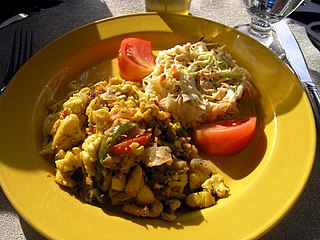 W
WAckee and saltfish is the Jamaican national dish prepared with ackee and salted codfish.
 W
WBammy is a traditional Jamaican cassava flatbread descended from the simple flatbread eaten by the Arawaks, Jamaica's original inhabitants. Today, it is produced in many rural communities and sold in stores and by street vendors in Jamaica and abroad.
 W
WThe ackee, also known as ankye, achee, akee, ackee apple or ayee is a fruit of the Sapindaceae soapberry family, as are the lychee and the longan. It is native to tropical West Africa. The scientific name honours Captain William Bligh who took the fruit from Jamaica to the Royal Botanic Gardens in Kew, England in 1793. The English common name is derived from the West African Akan akye fufo.
 W
WBreadfruit is a species of flowering tree in the mulberry and jackfruit family (Moraceae) believed to be a domesticated descendant of Artocarpus camansi originating in New Guinea, the Maluku Islands, and the Philippines. It was initially spread to Oceania via the Austronesian expansion. It was further spread to other tropical regions of the world during the Colonial Era. British and French navigators introduced a few Polynesian seedless varieties to Caribbean islands during the late 18th century. Today it is grown in some 90 countries throughout South and Southeast Asia, the Pacific Ocean, the Caribbean, Central America and Africa. Its name is derived from the texture of the moderately ripe fruit when cooked, similar to freshly baked bread and having a potato-like flavor.
 W
WBulla cake, usually referred to as bulla, is a rich Jamaican cake made with molasses and spiced with ginger and nutmeg, sometimes dark-colored and other times light-colored. Bulla are small loaves that are flat and round. They are inexpensive and easy to make using molasses, flour and baking soda. Bulla is traditionally a popular treat for schoolchildren. It is usually eaten with cheese, butter or avocado.
 W
WCalabaza is the generic name in the Spanish language for any type of pumpkin. Within an English-language context it specifically refers to what is known as West Indian pumpkin or also calabassa, a winter squash typically grown in the West Indies, tropical America, and the Philippines. Calabaza is the common name for Cucurbita moschata in Cuba, Florida, Puerto Rico, and the Philippines. C. moschata is also known as auyama in the Dominican Republic; ayote in Central America; zapallo in certain countries of South America; and "pumpkin", "squash", or "calabash" in English-speaking islands.
 W
WManihot esculenta, commonly called cassava, manioc, or yuca is a woody shrub of the spurge family, Euphorbiaceae, native to South America. Although a perennial plant, cassava is extensively cultivated as an annual crop in tropical and subtropical regions for its edible starchy tuberous root, a major source of carbohydrates. Though it is often called yuca in parts of Spanish America and in the United States, it is not related to yucca, a shrub in the family Asparagaceae. Cassava is predominantly consumed in boiled form, but substantial quantities are used to extract cassava starch, called tapioca, which is used for food, animal feed, and industrial purposes. The Brazilian farinha, and the related garri of West Africa, is an edible coarse flour obtained by grating cassava roots, pressing moisture off the obtained grated pulp, and finally drying it.
 W
WCoco bread is eaten in Jamaica and other areas of the Caribbean. The bread contains some coconut milk, and is starchy and slightly sweet in taste. It is often split in half and stuffed with a Jamaican patty to form a sandwich.
 W
WCooking bananas are banana cultivars in the genus Musa whose fruits are generally used in cooking. They may be eaten ripe or unripe and are generally starchy. Many cooking bananas are referred to as plantains or green bananas. In botanical usage, the term "plantain" is used only for true plantains, while other starchy cultivars used for cooking are called "cooking bananas". True plantains are cultivars belonging to the AAB Group, while cooking bananas are any cultivars belonging to AAB, AAA, ABB, or BBB groups. The currently accepted scientific name for all such cultivars in these groups is Musa × paradisiaca. Fe'i bananas from the Pacific Islands are often eaten roasted or boiled, and are thus informally referred to as "mountain plantains," but they do not belong to any of the species from which all modern banana cultivars are descended.
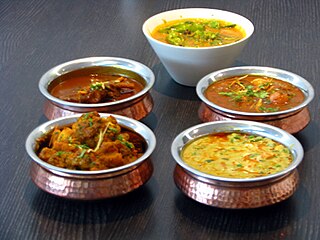 W
WA curry is a dish with a sauce seasoned with spices, mainly associated with South Asian cuisine. The spices commonly include turmeric, cumin, coriander, ginger, and chili pepper, among others. In southern India, leaves from the curry tree may be included.
 W
WDried and salted cod, sometimes referred to as salt cod or saltfish or salt dolly, is cod which has been preserved by drying after salting. Cod which has been dried without the addition of salt is stockfish. Salt cod was long a major export of the North Atlantic region, and has become an ingredient of many cuisines around the Atlantic and in the Mediterranean.
 W
WEscabeche is the name for a number of dishes in Spanish, Portuguese, Filipino and Latin American cuisines, consisting of marinated fish, meat or vegetables, cooked in an acidic sauce, and colored with paprika, citrus, and other spices.
 W
WFish tea is a spicy soup in Caribbean cuisine and Jamaican cuisine. It is similar to a fish bouillon and can take several hours to prepare. It includes ground yam, pumpkin, cassava, potatoes and green bananas, cooked until very soft. As much as 15 pounds of fish is added to make five gallons. Carrots and cho–cho can also be added. It is flavored with coconut milk and seasoned with various ingredients that may include black pepper, salt, thyme, butter, scallion and season–all."
 W
WTraditional ginger beer is a sweetened and carbonated, usually non-alcoholic beverage. Historically it was produced by the natural fermentation of prepared ginger spice, yeast and sugar.
 W
WGizzada or grizzada, also referred to as pinch-me-round, and known as queijada in the Portuguese language, is a pastry in Jamaican cuisine and Portuguese cuisine. The tart is contained in a small, crisp pastry shell with a pinched crust and filled with a sweet and spiced coconut filling. Trinidad also has a similar treat referred to as the coconut tart.
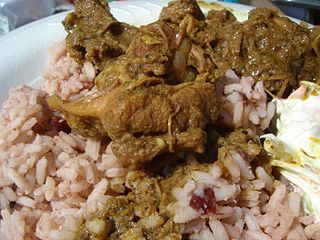 W
WGoat curry is a curry dish prepared with goat meat, originating from the Indian subcontinent and Southeast Asia. The dish is a staple in Southeast Asian cuisine, Caribbean cuisine, and cuisine of the Indian subcontinent. In Southeast Asia, the dish was brought by Indian diaspora in the region, and subsequently has influenced local cuisine. This dish has spread throughout the Caribbean and also the Indo-Caribbean diaspora in North America and Europe.
 W
WGolden Krust Caribbean Bakery, Inc. is a Caribbean Fast casual restaurant operator and manufacturer of Caribbean cuisine including Jamaican food, Jamaican patty, and other baked goods.
 W
WHorlicks is a sweet malted milk hot drink powder developed by founders James and William Horlick. It was first sold as "Horlick's Infant and Invalids Food," soon adding "aged and travellers" to their label. In the early 20th century, it was sold as a powdered meal replacement drink mix.
 W
WA hush puppy is a small, savoury, deep-fried round ball made from cornmeal-based batter. Hushpuppies are frequently served as a side dish with seafood and other deep-fried foods.
 W
WIrish moss is a Jamaican beverage in which the main ingredient is the marine red algae Gracilaria spp., boiled in milk with sugar or honey and various spices added such as vanilla, cinnamon, and nutmeg. Depending on the recipe, other ingredients may include sweetened condensed milk and additional thickening agents such as gum arabic or isinglass, as well as ingredients like rolled oats or linseed oil to add extra fat content. A peanut-flavored version is also widely available, which is based upon another drink popular in Jamaica, peanut punch.
 W
WIrn-Bru is a Scottish carbonated soft drink, often described as "Scotland's other national drink". Introduced in 1901, the drink is produced in Westfield, Cumbernauld, North Lanarkshire, by A.G. Barr of Glasgow.
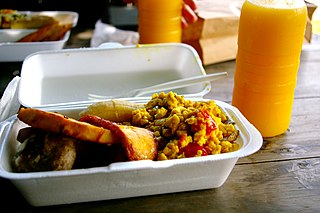 W
WItal, also spelled I-tal, is food often celebrated by those in the Rastafari movement. It is compulsory in the Bobo Ashanti and Nyabinghi mansions, though not in the Twelve Tribes of Israel. The word derives from the English word "vital", with the initial "v" removed. This emphasis on the letter "I" is done to many words in the Rastafari vocabulary to signify the unity of the speaker with all of nature. The expression of Ital eating varies widely from Rasta to Rasta, and there are few universal rules of Ital living.
 W
WA Jamaican patty is a pastry that contains various fillings and spices baked inside a flaky shell, often tinted golden yellow with an egg yolk mixture or turmeric. It is made like a turnover, but is more savoury and filled with meat. As its name suggests, it is commonly found in Jamaica, and is also eaten in other areas of the Caribbean, such as the Caribbean coast of Nicaragua and Costa Rica. It is traditionally filled with seasoned ground beef, but fillings can include chicken, pork, lamb, vegetables, shrimp, lobster, fish, soy, ackee, mixed vegetables or cheese. In Jamaica, the patty is often eaten as a full meal, especially when paired with coco bread. It can also be made as bite-sized portions called cocktail patties. Among the Jamaican diaspora in the United Kingdom, the pastry is more like that of a suet crust, and often made with margarine or butter, which provides the flaky pastry, and curry powder containing turmeric, which provides the yellow colour.
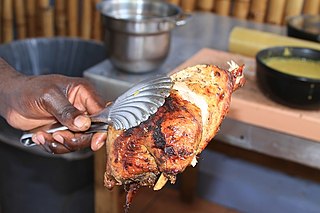 W
WJerk is a style of cooking native to Jamaica, in which meat is dry-rubbed or wet marinated with a hot spice mixture called Jamaican jerk spice.
 W
WOxtail is the culinary name for the tail of cattle. While the word once meant only the tail of an ox, today it can also refer to the tails of other cattle. An oxtail typically weighs 7–8 lb (3.2–3.6 kg) and is skinned and cut into short lengths for sale.
 W
WPeg bread is a traditional Jamaican and West Indian bread type. It is usually served along with tea in the morning.
 W
WPickapeppa Sauce, also known as Jamaican ketchup, is a brand name Jamaican condiment, the main product of the Pickapeppa Company, founded in 1921. It is made in Shooters Hill, Jamaica, near Mandeville. The ingredients are: cane vinegar, sugar, tomatoes, onions, raisins, sea salt, ginger, peppers, garlic, cloves, black pepper, thyme, mangoes, and orange peel, aged in oak barrels. The sauce is sweet, sour and mildly spicy. The company makes several variants of the sauce, including mango and extra hot Scotch Bonnet pepper varieties.
 W
WRice and peas or peas and rice is a traditional food within the West Indian Caribbean islands. The 'peas' are traditionally pigeon peas, but more often substituted with kidney beans, and the dish is frequently served with curry goat.
 W
WA rock cake, also called a rock bun, is a small cake with a rough surface resembling a rock. They were promoted by the Ministry of Food during the Second World War since they require fewer eggs and less sugar than ordinary cakes, an important savings in a time of strict rationing. Traditional recipes bulked them with oatmeal, which was more readily available than white flour.
 W
WRoti is a round flatbread native to the Indian subcontinent made from stoneground whole wheat flour, traditionally known as gehu ka atta, and water that is combined into a dough. Roti is consumed in many countries worldwide. Its defining characteristic is that it is unleavened. Naan from the Indian subcontinent, by contrast, is a yeast-leavened bread, as is kulcha. Like breads around the world, roti is a staple accompaniment to other foods.
 W
WSolomon Gundy is a Jamaican pickled fish pâté usually served with crackers as an appetizer.
 W
WSoursop is the fruit of Annona muricata, a broadleaf, flowering, evergreen tree. The exact origin is unknown; it is native to the tropical regions of the Americas and the Caribbean and is widely propagated. It is in the same genus, Annona, as cherimoya and is in the Annonaceae family.
 W
WStamp and Go is a fish fritter made with salt fish in Jamaican cuisine. It is part of a Jamaican breakfast. It is referred to as one of the original fast foods in Jamaica. The unusual name is supposed to have derived from the 18th-century British sailing ships. If an officer wanted something to be done in a hurry the order was "Stamp and Go!". These bite-sized, salty delights are a favorite at cocktail parties served with tangy dips. The larger ones are popular for breakfast, and were very popular as "journey" food many years ago.
 W
WTing is a carbonated beverage popular in the Caribbean. It is flavored with Jamaican grapefruit juice and is both tart and sweet. Ting comes in a green glass bottle, green plastic bottle or a green and yellow can. Like Orangina, the beverage contains a small amount of sediment consisting of grapefruit juice pulp. Ting is produced in the United Kingdom under license by Cott Beverages. Ting also now makes Pink Ting Soda, Orange Ting, Diet Ting Soda, and ginger beer.
 W
WA water biscuit or water cracker is a type of biscuit or cracker. They are thin, hard and brittle, and usually served with cheese or wine. Originally produced in the 19th century as a version of the ship's biscuit, water biscuits continue to be popular in Ireland and the United Kingdom, with the leading brands selling over seventy million packets a year.